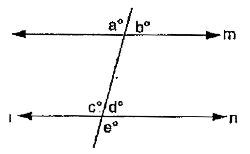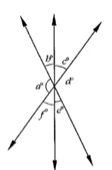In the given figure , lines m and n are not parallel and will intersect at some point to the right of the page Which of the following statements is / are true ?
(I)c=e (II)b>d (III)a=c

Step by step video & image solution for In the given figure , lines m and n are not parallel and will intersect at some point to the right of the page Which of the following statements is / are true ? (I) c=e (II) b gt d (III) a=c by Maths experts to help you in doubts & scoring excellent marks in Class 7 exams.
Topper's Solved these Questions
- BOOK - S CHAND IIT JEE FOUNDATIONCHAPTER - LINES AND ANGLES EXERCISE - QUESTIONS BANK22videos
LINES AND ANGLES
- BOOK - S CHAND IIT JEE FOUNDATIONCHAPTER - LINES AND ANGLES EXERCISE - SELF ASSESSMENT SHEET10videos
LINES AND ANGLES
- BOOK - S CHAND IIT JEE FOUNDATIONCHAPTER - LINEAR EQUATIONS IN ONE VARIABLEEXERCISE - Unit Test -220videos
LINEAR EQUATIONS IN ONE VARIABLE
- BOOK - S CHAND IIT JEE FOUNDATIONCHAPTER - NUMBERSEXERCISE - SELF ASSESSMENT SHEET-110videos
NUMBERS
Similar Questions
In Figure, which of the following statements must be true? (i) a+b=d+c (ii) a+c+e=1800 (iii) b+f=c+e (a) (i) only (b) (ii) only (c) (iii) only (d) (ii) and (iii) only
 View Solution
View SolutionIn given questions below are given three statements followed by three conclusions numbered I,II,and III. You have to take the given statements to be true even if they seem to be at variance from the commonly known facts. Read all the conclusions and then decide which of the given conclusions logically follows from the given statements disregarding commonly known facts.
Statements: Some blades are hammers. Some hammers are knives. Some knives are axes.
Conclusion: I. Some axes are hammers.
II. Some knives are blades.
III. Some axes are blades.
(a) None follows
(b) Only I follows
(c) Only II follows
(d) Only III follow
(e) None of these.View Solution
Knowledge Check
- Question 1 - Select One
(i)M is the brother of N
(ii) B is the brother of N,and
(iii)M is the brother of D, which of the following statements is definitely true?AN is the brother of BBN is the brother of DCM is the brother of BDD is the brother of M - Question 2 - Select One
If a, b, c, d and e are positve numbers, and it is given that ,
a+b=c+db+d=2ad+e>a+bandc+d>a+e
then, which of the following statement is true ?Ad>a>b>e>cBd>b>e>a>cCa>b>c>d>eDa>d>b>e>c - Question 3 - Select One
In the following questions statement have different relations between different element. Now according to statement there are two conclusion are give :-
निम्नलिखित प्रश्नों में कथन के विभिन्न तत्वों के बीच अलग-अलग संबंध हैं। अब कथन के अनुसार दो निष्कर्ष दिए गए हैं:-
Statements (कथन) : A=B>C<D=E<F
Conclusions (निष्कर्ष) : I. F>B
II. B>DAIf only conclusion I is true (यदि केवल निष्कर्ष I सत्य है)BIf only conclusion II is true (यदि केवल निष्कर्ष II सत्य है)CIf neither I nor II is true (यदि न तो I और न ही II सत्य है)DIf conclusion I and II both are true (यदि निष्कर्ष I और II दोनों सत्य हैं)
In given questions, two statements are given followed by three or four conclusions numbered I, II, III and IV. You have to take the given statements to be true even if they seem to be at variance from the commonly know facts and then decide which of the given conclusions logically follows from the given statement disregarding commonly know facts.
Statement : Some bags are pockets. No pocket is a pouch.
Conclusions : I. No bag is a pouch.
II. Some bags are not pouches.
III. Some pockets are bags.
IV. No pocket is a bag.
(a) None follows
(b) Only I and III follow
(c) Only II and III follow
(d) Only either I or IV follows
(e) All followView SolutionIn given questions below are given three statements followed by three conclusions numbered I,II,and III. You have to take the given statements to be true even if they seem to be at variance from the commonly known facts. Read all the conclusions and then decide which of the given conclusions logically follows from the given statements disregarding commonly known facts.
Statements: No rabbit is lion. Some horses are lions. All rabbits are tables.
Conclusions: I. Some tables are lions.
II. Some horses are rabbits.
III. No lion is table.
(a) None follows
(b) Only either I or III follows
(c) Only II and III follows
(d) Only III follows
(e) None of these.View SolutionIn given questions below are given three statements followed by three conclusions numbered I,II,and III. You have to take the given statements to be true even if they seem to be at variance from the commonly known facts. Read all the conclusions and then decide which of the given conclusions logically follows from the given statements disregarding commonly known facts.
Statements: Some towels are brushes. No brush is soap. All soaps are rats.
Conclusions I. Some rats are brushes.
II. No rat is brush.
III. Some towels are soaps.
(a) None follows
(b) Only either I or II follows
(c) Only II follows
(d) Only I and III follows
(e) None of these.View SolutionIn the given questions assuming the given statements to be true, find which of the following, conclusion I and II given below is/are definitely true and give your answer accordingly:
Statements:
B ≤ K, K > M, C ≤ M
Conclusions:
I. B ≤ C
II. K ≥ CView SolutionIn the given questions assuming the given statements to be true, find which of the following, conclusion I and II given below is/are definitely true and give your answer accordingly:
Statements:
B ≤ K, K > M, C ≤ M
Conclusions:
I. B = C
II. K > CView Solution

